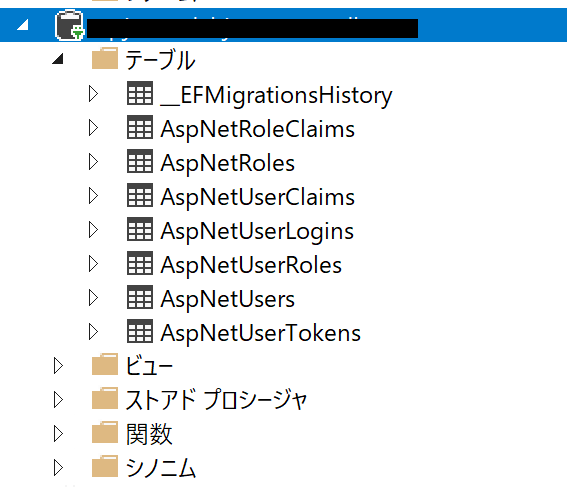おはようございます、本日はAPI経由でユーザー登録・アクセス管理をするためのコンポーネントを見ていきます。今日は準備編。
環境
- Visual Studio Professional 2017 15.9.4
- ASP.NET Core 2.2 (2.1からアップグレードする必要がある方はこちら参照)
ASP.NETにはASP.NET Core Identityと呼ばれるライブラリーがあります。このライブラリーを使ってユーザーのアクセスをコントロールすることができます。(ASP.NET Core 2.2に含まれています)
本家のドキュメントはこちらをご参照ください。
https://docs.microsoft.com/en-us/aspnet/core/security/authentication/identity?view=aspnetcore-2.2&tabs=visual-studio
DBの場所を指定
ユーザー情報、パスワード、プロフィール情報等々はMS SQL、ストレージなどを使うことができます。今回はMS SQLを利用します。 appsetting.jsonにてDBの場所を指定します。(今回はユーザーデータベースだけ別のデータベースとして立てています、メインのDBと一緒でも問題はありません)
{
"ConnectionStrings": {
"DefaultConnection": "Server=tcp:{server location},1433;Initial Catalog={db name};Persist Security Info=False;User ID={user id};Password={password};MultipleActiveResultSets=False;Encrypt=True;TrustServerCertificate=False;Connection Timeout=30;",
"UserDabtaseConnection": "Server=tcp:{server location},1433;Initial Catalog={db name};Persist Security Info=False;User ID={user name};Password={password};MultipleActiveResultSets=False;Encrypt=True;TrustServerCertificate=False;Connection Timeout=30;"
},
"Logging": {
"LogLevel": {
"Default": "Warning"
}
},
"AllowedHosts": "*"
}
モデルを準備
ApplicationUserModelsという名前でユーザー情報を扱うデータモデルを作ります。 一旦 IdentityUserを継承するだけにしておきます。
using Microsoft.AspNetCore.Identity;
namespace SampleApi.Models.ApplicationUserDataModel.DataModels
{
public class ApplicationUserDataModel : IdentityUser
{
}
}
ApplicationDbContextクラスの準備
IdentityDbContextを継承する
using SampleApi.Models.ApplicationUsers.DataModels;
using Microsoft.AspNetCore.Identity.EntityFrameworkCore;
using Microsoft.EntityFrameworkCore;
namespace SampleApi.Handlers
{
public class ApplicationDbContext : IdentityDbContext<ApplicationUserModels>
{
public ApplicationDbContext(DbContextOptions options) : base(options)
{
}
}
}
DB更新
ここで一旦DBを更新ます。パッケージマネージャーコンソールより、マイグレーションを起動します。
add-migration addusers -context ApplicationDbContext
マイグレーションが終わると下記のマイグレーションコードが生成されます。
using System;
using Microsoft.EntityFrameworkCore.Metadata;
using Microsoft.EntityFrameworkCore.Migrations;
namespace SampleApi.Migrations.ApplicationDb
{
public partial class addusers : Migration
{
protected override void Up(MigrationBuilder migrationBuilder)
{
migrationBuilder.CreateTable(
name: "AspNetRoles",
columns: table => new
{
Id = table.Column<string>(nullable: false),
Name = table.Column<string>(maxLength: 256, nullable: true),
NormalizedName = table.Column<string>(maxLength: 256, nullable: true),
ConcurrencyStamp = table.Column<string>(nullable: true)
},
constraints: table =>
{
table.PrimaryKey("PK_AspNetRoles", x => x.Id);
});
migrationBuilder.CreateTable(
name: "AspNetUsers",
columns: table => new
{
Id = table.Column<string>(nullable: false),
UserName = table.Column<string>(maxLength: 256, nullable: true),
NormalizedUserName = table.Column<string>(maxLength: 256, nullable: true),
Email = table.Column<string>(maxLength: 256, nullable: true),
NormalizedEmail = table.Column<string>(maxLength: 256, nullable: true),
EmailConfirmed = table.Column<bool>(nullable: false),
PasswordHash = table.Column<string>(nullable: true),
SecurityStamp = table.Column<string>(nullable: true),
ConcurrencyStamp = table.Column<string>(nullable: true),
PhoneNumber = table.Column<string>(nullable: true),
PhoneNumberConfirmed = table.Column<bool>(nullable: false),
TwoFactorEnabled = table.Column<bool>(nullable: false),
LockoutEnd = table.Column<DateTimeOffset>(nullable: true),
LockoutEnabled = table.Column<bool>(nullable: false),
AccessFailedCount = table.Column<int>(nullable: false)
},
constraints: table =>
{
table.PrimaryKey("PK_AspNetUsers", x => x.Id);
});
migrationBuilder.CreateTable(
name: "AspNetRoleClaims",
columns: table => new
{
Id = table.Column<int>(nullable: false)
.Annotation("SqlServer:ValueGenerationStrategy", SqlServerValueGenerationStrategy.IdentityColumn),
RoleId = table.Column<string>(nullable: false),
ClaimType = table.Column<string>(nullable: true),
ClaimValue = table.Column<string>(nullable: true)
},
constraints: table =>
{
table.PrimaryKey("PK_AspNetRoleClaims", x => x.Id);
table.ForeignKey(
name: "FK_AspNetRoleClaims_AspNetRoles_RoleId",
column: x => x.RoleId,
principalTable: "AspNetRoles",
principalColumn: "Id",
onDelete: ReferentialAction.Cascade);
});
migrationBuilder.CreateTable(
name: "AspNetUserClaims",
columns: table => new
{
Id = table.Column<int>(nullable: false)
.Annotation("SqlServer:ValueGenerationStrategy", SqlServerValueGenerationStrategy.IdentityColumn),
UserId = table.Column<string>(nullable: false),
ClaimType = table.Column<string>(nullable: true),
ClaimValue = table.Column<string>(nullable: true)
},
constraints: table =>
{
table.PrimaryKey("PK_AspNetUserClaims", x => x.Id);
table.ForeignKey(
name: "FK_AspNetUserClaims_AspNetUsers_UserId",
column: x => x.UserId,
principalTable: "AspNetUsers",
principalColumn: "Id",
onDelete: ReferentialAction.Cascade);
});
migrationBuilder.CreateTable(
name: "AspNetUserLogins",
columns: table => new
{
LoginProvider = table.Column<string>(nullable: false),
ProviderKey = table.Column<string>(nullable: false),
ProviderDisplayName = table.Column<string>(nullable: true),
UserId = table.Column<string>(nullable: false)
},
constraints: table =>
{
table.PrimaryKey("PK_AspNetUserLogins", x => new { x.LoginProvider, x.ProviderKey });
table.ForeignKey(
name: "FK_AspNetUserLogins_AspNetUsers_UserId",
column: x => x.UserId,
principalTable: "AspNetUsers",
principalColumn: "Id",
onDelete: ReferentialAction.Cascade);
});
migrationBuilder.CreateTable(
name: "AspNetUserRoles",
columns: table => new
{
UserId = table.Column<string>(nullable: false),
RoleId = table.Column<string>(nullable: false)
},
constraints: table =>
{
table.PrimaryKey("PK_AspNetUserRoles", x => new { x.UserId, x.RoleId });
table.ForeignKey(
name: "FK_AspNetUserRoles_AspNetRoles_RoleId",
column: x => x.RoleId,
principalTable: "AspNetRoles",
principalColumn: "Id",
onDelete: ReferentialAction.Cascade);
table.ForeignKey(
name: "FK_AspNetUserRoles_AspNetUsers_UserId",
column: x => x.UserId,
principalTable: "AspNetUsers",
principalColumn: "Id",
onDelete: ReferentialAction.Cascade);
});
migrationBuilder.CreateTable(
name: "AspNetUserTokens",
columns: table => new
{
UserId = table.Column<string>(nullable: false),
LoginProvider = table.Column<string>(nullable: false),
Name = table.Column<string>(nullable: false),
Value = table.Column<string>(nullable: true)
},
constraints: table =>
{
table.PrimaryKey("PK_AspNetUserTokens", x => new { x.UserId, x.LoginProvider, x.Name });
table.ForeignKey(
name: "FK_AspNetUserTokens_AspNetUsers_UserId",
column: x => x.UserId,
principalTable: "AspNetUsers",
principalColumn: "Id",
onDelete: ReferentialAction.Cascade);
});
migrationBuilder.CreateIndex(
name: "IX_AspNetRoleClaims_RoleId",
table: "AspNetRoleClaims",
column: "RoleId");
migrationBuilder.CreateIndex(
name: "RoleNameIndex",
table: "AspNetRoles",
column: "NormalizedName",
unique: true,
filter: "[NormalizedName] IS NOT NULL");
migrationBuilder.CreateIndex(
name: "IX_AspNetUserClaims_UserId",
table: "AspNetUserClaims",
column: "UserId");
migrationBuilder.CreateIndex(
name: "IX_AspNetUserLogins_UserId",
table: "AspNetUserLogins",
column: "UserId");
migrationBuilder.CreateIndex(
name: "IX_AspNetUserRoles_RoleId",
table: "AspNetUserRoles",
column: "RoleId");
migrationBuilder.CreateIndex(
name: "EmailIndex",
table: "AspNetUsers",
column: "NormalizedEmail");
migrationBuilder.CreateIndex(
name: "UserNameIndex",
table: "AspNetUsers",
column: "NormalizedUserName",
unique: true,
filter: "[NormalizedUserName] IS NOT NULL");
}
protected override void Down(MigrationBuilder migrationBuilder)
{
migrationBuilder.DropTable(
name: "AspNetRoleClaims");
migrationBuilder.DropTable(
name: "AspNetUserClaims");
migrationBuilder.DropTable(
name: "AspNetUserLogins");
migrationBuilder.DropTable(
name: "AspNetUserRoles");
migrationBuilder.DropTable(
name: "AspNetUserTokens");
migrationBuilder.DropTable(
name: "AspNetRoles");
migrationBuilder.DropTable(
name: "AspNetUsers");
}
}
}
マイグレーションコードを一度確認し、次は実際にDBに対して更新を行います。
PM > update-database -context ApplicationDbContext
これでDBは更新されました。内容を確認してみましょう。Visual StudioのサーバーエクスプローラーよりDBを確認すると下記のようにユーザー管理に必要な新しいテーブルが生成されています。
IdentityをDIする
Startup.csにてIdentityが使えるようDIします。
services.AddIdentity<ApplicationUserDataModel, IdentityRole>()
.AddEntityFrameworkStores<ApplicationDbContext>()
.AddDefaultTokenProviders();
を追加します。下記がフルstartup.csファイルです。
using SampleApi.Filters;
using SampleApi.Handlers;
using Microsoft.AspNetCore.Builder;
using Microsoft.AspNetCore.Hosting;
using Microsoft.AspNetCore.Http;
using Microsoft.AspNetCore.Mvc;
using Microsoft.EntityFrameworkCore;
using Microsoft.Extensions.Configuration;
using Microsoft.Extensions.DependencyInjection;
using Microsoft.Extensions.Options;
using Swashbuckle.AspNetCore.Swagger;
using System;
using System.IO;
using System.Reflection;
using SampleApi.Models.ApplicationUsers.DataModels;
using Microsoft.AspNetCore.Identity;
namespace SampleApi
{
public class Startup
{
public Startup(IConfiguration configuration, IOptions<AppSettings> optionsAccessor)
{
Configuration = configuration;
}
public IConfiguration Configuration { get; }
// This method gets called by the runtime. Use this method to add services to the container.
public void ConfigureServices(IServiceCollection services)
{
services.AddMvc().SetCompatibilityVersion(CompatibilityVersion.Version_2_1);
services.AddSingleton<IHttpContextAccessor, HttpContextAccessor>();
//Sql
services.AddDbContext<ApplicationDbContext>(options =>
options.UseSqlServer(
Configuration.GetConnectionString("UserDabtaseConnection")));
// ADDED
services.AddIdentity<ApplicationUserDataModel, IdentityRole>()
.AddEntityFrameworkStores<ApplicationDbContext>()
.AddDefaultTokenProviders();
// Register the Swagger generator, defining 1 or more Swagger documents
services.AddSwaggerGen(c =>
{
c.SwaggerDoc("v1", new Info
{
Title = "{title}",
Version = "1",
Description = "{description}",
Contact = new Contact
{
Name = "{name}",
Email = "{email}",
Url = "{url}"
}
});
c.OperationFilter<AddAuthorizationHeaderParameterOperationFilter>();
// Set the comments path for the Swagger JSON and UI.
string xmlFile = $"{Assembly.GetExecutingAssembly().GetName().Name}.xml";
string xmlPath = Path.Combine(AppContext.BaseDirectory, xmlFile);
c.IncludeXmlComments(xmlPath);
});
}
// This method gets called by the runtime. Use this method to configure the HTTP request pipeline.
public void Configure(IApplicationBuilder app, IHostingEnvironment env)
{
if (env.IsDevelopment())
{
app.UseDeveloperExceptionPage();
}
else
{
app.UseHsts();
}
// Enable middleware to serve generated Swagger as a JSON endpoint.
app.UseSwagger();
// Enable middleware to serve swagger-ui (HTML, JS, CSS, etc.),
// specifying the Swagger JSON endpoint.
app.UseSwaggerUI(c =>
{
c.SwaggerEndpoint("/swagger/v1/swagger.json", "{name}");
c.RoutePrefix = string.Empty;
});
// ADDED
app.UseAuthentication();
app.UseHttpsRedirection();
app.UseMvc();
}
}
}
Startup.csにてSwaggerが設定されています、Swaggerの設定方法に関してはこちらを参照してみてください。
https://qiita.com/syantien/items/b82879afad3b4c18f224
次
ここから次は色々なメソッドを追加して、実際にユーザーを登録や、ロール登録等々をしていきます。
次回:ASP.NET Core 2 API x Identity でユーザー登録とアクセスを管理(JWT) 2. 基本メソッド編 (ログイン)
